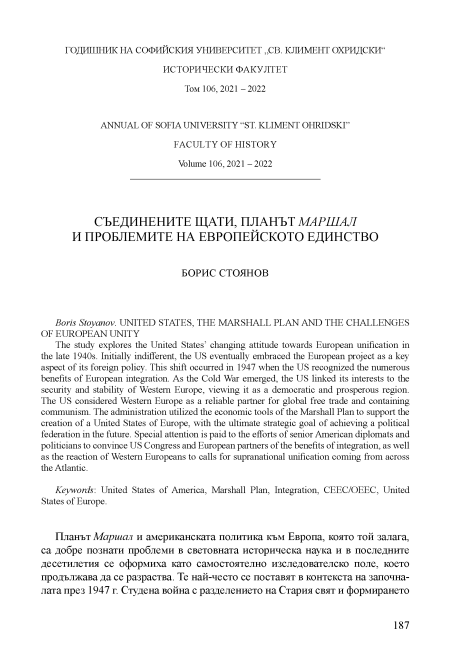United States, the Marshall Plan and the Challenges of European Unity
DOI:
https://doi.org/10.60053/GSU.IF.1.106.187-252Keywords:
United States of America, Marshall Plan, Integration, CEEC/OEEC, United States of EuropeAbstract
The study explores the United States’ changing attitude towards European unification in the late 1940s. Initially indifferent, the US eventually embraced the European project as a key aspect of its foreign policy. This shift occurred in 1947 when the US recognized the numerous benefits of European integration. As the Cold War emerged, the US linked its interests to the security and stability of Western Europe, viewing it as a democratic and prosperous region. The US considered Western Europe as a reliable partner for global free trade and containing communism. The administration utilized the economic tools of the Marshall Plan to support the creation of a United States of Europe, with the ultimate strategic goal of achieving a political federation in the future. Special attention is paid to the efforts of senior American diplomats and politicians to convince US Congress and European partners of the benefits of integration, as well as the reaction of Western Europeans to calls for supranational unification coming from across the Atlantic.
References
АРХИВИ
Documents on the History of European Integration. Gen. ed. Walter Lipgens. Walter de Gruyter Vol. 1. Continental Plans for European Union, 1939-1945 (1985); Vol. 2. Plans for European Union in Great Britain and in Exile, 1939-1945 (1986).
U.S. Department of State, Foreign Relations of the United States Series. Washington, D.C.: U.S. Government Printing Office: 1946 Vol. 5. The British Commonwealth; Western and Central Europe (1969); 1947 Vol. 2. Council of Foreign Ministers; Germany and Austria (1972); 1947 Vol. 3. The British Commonwealth; Europe (1972); 1948 Vol. 3. Western Europe (1974).
U.S. Congress, House, Committee on Foreign Affairs, Hearings, US Foreign Policy for a Postwar Recovery Program, 80th Congress, 1st and 2nd sess., 1947-1948.
U.S. Congress, Senate, 80th Cong., 1st sess., Congressional Record, Senate, 1947, Vol. 93.
U.S. Congress, Senate, 80th Cong., 2nd sess., Congressional Record Senate, 1948, Vol. 94.U.S. Congress, Senate, Committee on Foreign Relations, Hearings, European Recovery Program, 80th Congress, 2nd sess., 1948. The University of Luxemburg CVCE.eu [online]. Available from: https://www.cvce.eu/ en/collections/unit-content/-/unit/02bb76df-d066-4c08-a58a-d4686a3e68 New York Herald Tribune: 18.01.1947.
U.S. Department of State, Bulletin: 15.09.1946; 11.05.1947; 15.06.1947. Washington Post: 1.05.1947; 21.01.1947; 5.04.1947.
ЛИТЕРАТУРА
Болън, Чарлс. Свидетел на историята, 1929-1969. Университетско издателство „Св. Климент Охридски“, 2020.
Стоянов, Борис. Проблемите на европейското единство в политиката на Великобритания и Съветския съюз, 1941-1944 г. В: Баева, Искра, състав. Втората световна война: 70 години по-късно. Сб. статии. Университетско издателство „Св. Климент Охридски“, 2018.
Стоянов, Борис. Обединена Европа в плановете на антихитлеристкия лагер в годините на Втората световна война. В: Стоянов, Борис, Алексиева, Гергана, състав. История в преход. Сб. статии в чест на проф. дин Драгомир Драганов. Университетско издателство „Св. Климент Охридски“, 2008.
Acheson, Dean. Present at the Creation: M y Years in the State Department. W. W. Norton, 1969.
Beisner, Robert L. Dean Acheson: A Life in the Cold War. Oxford University Press, 2006.
Beloff, Max. The United States and the Unity o f Europe. The Brookings Institution, 1963.
Bossuat, Gerard. L’Aide américaine à la France aprés la Seconde guerre Mondiale. In: Vingtieme Siecle, 1986, N 2.
Bullock, Alan. The Life and Times o f Ernest Bevin: Foreign Secretary, 1945-1951. William Heinemann Ltd., 1983.
Deighton, Anne. The Impossible Peace: Britain, the Division o f Germany, and the Origins o f the Cold War. Oxford University Press, 1990. Elwood, David. Rebuilding Europe: Western Europe, America and Postwar Reconstruction. Longman, 1992.
Elwood, David. Was the Marshall Plan Necessary? In: Alan S. Milward and a Century o f European Change. Ed. by Fernando Guirao, et al. Routledge, 2012.
Ferrell, Robert H. The Truman Era and European Integration. In: The United States and the Integration o f Europe: Legacies of the Postwar Era. Ed. by Francis Heller, John Gillingham. Palgrave Macmillan, 1996.
Funk, Arthur L. American and Soviet Views on Europe from Yalta to the Marshall Plan. In: Wartime Plans fo r Postwar Europe, 1940-1947. Ed. by Michel Dumoulin. Nomos, 1995.
Galante, Severino. ‘European Communism’ and the West: From Cooperation to Hostility. In: Europe, 1945-1990s: The End of an Era. Ed. by Antonio Varsori. Palgrave Macmillan, 1995.
Gaddis, John L. George Kennan: An American Life. The Penguin Press, 2011.G ardner, Richard N. Sterling - Dollar Diplomacy: The Origins and the Prospects of Our International Economic Order. 2nd ed., McGrawl-Hill Book Company, 1969.
Gillingham, John. Coal, Steel, and the Rebirth of Europe, 1945-1955: The Germans and French from Ruhr Conflict to Economic Community. Cambridge University Press, 2005.
Harper, John L. American Visions o f Europe: Franklin D. Roosevelt, George F. Kennan and Dean G. Acheson. Cambridge University Press, 1994.
Hindley, Meredith. How the Marshall Plan Came About? In: Humanities, 1998, November/ December .
Hogan, Michael J. The Search for a “Creative Peace”: The United States, European Unity, and the Origins of the Marshall Plan. Diplomatic History, 1982, N 3.
Hogan, Michael J. Paths to Plenty: Marshal Plan Planners and the Debate Over European Integration, 1947-1948. In: Pacific Historical Review, 1984, N 3.
Hogan, Michael J. The Marshall Plan: America, Britain and the Reconstruction of Western Europe, 1947-1952. Cambridge University Press, 1987.
Jones, Joseph M. The Fifteen Weeks (February 21 - June 5, 1947): An Inside Account of the Genesis of the Marshall Plan. Viking Press, 1955.
Kaplan, Lawrence S. The Conversion o f Senator Arthur H. Vandenberg. University Press of Kentucky, 2015.
Kennan, George F. Memoirs, 1925-1950. Pantheon Publ., 1983. Killick, John. The United States and European Reconstruction, 1945-1960. Fitzroy Dearborn Publ., 1997.
Lowe, Keith. Savage Continent: Europe in the Aftermath of World War II. Penguin Books, 2013.
Maier, Charles S. The Politics of Productivity: Foundations of American International Economic Policy After World War II. In: Between Power and Plenty: The Foreign Economic Policies of Advanced Industrial States. Ed. by Peter Katzenstein. University of Wisconsin Press, 1978.
Maier, Charles. Alliance and Autonomy: European Identity and US Foreign Policy Objectives in the Truman Years. In: The Truman Presidency. Ed. by Michael Lacey. Cambridge University Press, 1991.
Melandri, Pierre. Les Etats Unis face à l ’unification de l ’Europe, 1945-1954. Éditions a. Pedone, 1980.
Melandri, Pierre. The United States and the Process of European Integration. In: Europe, 1945-1990s: The End of an Era. Ed. by Antonio Varsori. Palgrave Macmillan, 1995.
Milward, Alan S. The Reconstruction o f Western Europe, 1945-1951. Methuen and Co Publ., 1984.
Rappaport, Armin. The United States and European Integration: The First Phase. In: Diplomatic History, 1981, N 2.
Reveillard, Christophe. Les premières tentatives de construction d ’une Europe fédérale. Des projets de la Résistance au Traité de C.E.D. (1940-1954). Francois-Xavier de Guibert, 2001.
Reynolds, David. Marshall Plan Commemorative Section. The European Response: Primacy of Policy. In: Foreign Affairs, 1997, May-June.
Rostow, Walter W. The Division o f Europe after World War II: 1946. University of Texas Press, 1981.Schwabe, Klaus. The United States and European Integration. In: Western Europe and Germany: The Beginnings o f European Integration, 1945-1960. Ed. by Clemens Wurm. Berg Publ., 1995.
Smith, Jean E. Lucius D. Clay: An American Life. Henry Holt and Company, 1980. Trachtenberg, Marc. A Constructed Peace: The making o f the European Settlement, 1945 1963. Princeton University Press, 1999.
Williams, Andrew J. “Reconstruction” before the Marshall Plan. In: Review o f International Studies, 2005, N 3.
Winand, Pascaline. Eisenhower, Kennedy and the United States o f Europe. St. Martin’s Press, 1993.
Bolan, Charls. Svidetel na istoriyata, 1929-1969. Universitetsko izdatelstvo „Sv. Kliment Ohridski“, 2020.
Stoyanov, Boris. Problemite na evropeyskoto edinstvo v politikata na Velikobritania i Savetskia sayuz, 1941-1944 g. V: Baeva, Iskra, sastav. Vtorata svetovna voyna: 70 godini po-kasno. Sb. statii. Universitetsko izdatelstvo „Sv. Kliment Ohridski“, 2018.
Stoyanov, Boris. Obedinena Evropa v planovete na antihitleristkia lager v godinite na Vtorata svetovna voyna. V: Stoyanov, Boris, Aleksieva, Gergana, sastav. Istoria v prehod. Sb. statii v chest na prof. din Dragomir Draganov. Universitetsko izdatelstvo „Sv. Kliment Ohridski“, 2008.

Downloads
Published
How to Cite
Issue
Section
Categories
License
Copyright (c) 2023 Борис Стоянов

This work is licensed under a Creative Commons Attribution 4.0 International License.
Annual of Sofia University "St. Kliment Ohridski" - Faculty of History (GSU-IF).







